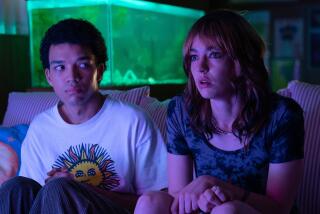‘Fault in Our Stars’ writer John Green has a good read on teens, tech
- Share via
John Green’s career as a book world phenom began auspiciously: His funny but tragic 2005 debut novel, “Looking for Alaska,” became a cult young adult hit and landed the American Library Assn.’s Printz Award for YA novel of the year. This was followed by 2006’s “An Abundance of Katherines,” a heavily footnoted romantic comedy shortlisted for the Printz and the Los Angeles Times Book Prize, and 2008’s “Paper Towns,” which nabbed an Edgar Award.
But it was 2012’s “The Fault in Our Stars,” featuring a heart-wrenching romance between intellectual teen cancer patients that cemented Green’s status as a YA superstar. It’s been on the L.A. Times bestseller list on and off for 79 weeks; the movie adaptation will hit theaters in June.
In addition to writing realistic books that treat young readers’ intelligence as a given, though, Green speaks to his audience in more direct ways. He and his brother, Hank, have built an online community of “Nerdfighters.” It began in 2007 as an experiment in video communication; now the duo — known as the Vlogbrothers — have more than 1.9 million YouTube subscribers and Green has 2.2 million Twitter followers (@realjohngreen).
FULL COVERAGE: Festival of Books
They harness the power of their followers with an annual Project for Awesome fundraiser coordinated by the charitable Foundation to Decrease World Suck. In 2013 the project raised more than $850,000 for various charities. Last year President Obama took part in an online hangout with Green after the State of the Union, uttering the Nerdfighter catchphrase, “don’t forget to be awesome.”
Green will receive the Innovator’s Award at the Los Angeles Times Book Prizes ceremony on April 11 for his work building a vibrant community at the intersection of literature, technology and activism. He spoke by phone from his home in Indianapolis, where he lives with his wife and two children, about technology, activism and the future of reading.
On technology and community:
The question for me has always been, is there a way that we can use this technology to build places for engagement, instead of just places for distraction? The Internet will continue to be a wonderful aggregator for activism and nonprofit work. The challenge is going to be making sure that we can take that work offline, because while we like to think that everybody’s on the Internet and everybody’s on Twitter and Facebook, the truth is that a lot of people aren’t and that a lot of the work that needs to be done can’t be done on the Internet.
On teens and activism:
For all the horrible things that adults say about teenagers, teenagers just continue to be intellectually curious, extremely passionate, concerned about the problems of the world and determined to change them. They are a huge inspiration to me because they believe, rightly, that the way things are isn’t the way that they have to be....
Having so many young people in the Nerdfighter community since the beginning has been really important, because they’ve pushed Hank and me to think harder about what are the most efficient ways to decrease what they call “world suck.” What are the things that we need to be focused on as a community, where can we do the most good?
The future of publishing:
We need to be a little less nervous than we are. I think we’re making the transition from print books to digital books relatively well. I wish there were more thriving bookstores, but there are still lots. That’s the first thing to take comfort in.
The second thing to take comfort in is that young people are reading, and they’re reading for pleasure, and they’re reading for pleasure in the millions. Most of them are reading at least a book or two a year for pleasure on top of all the books that they have to read for school, and that’s very encouraging. If we capture those people now — not to sound cynical about it — we will have them for 60 more years.
On misconceptions about YA fiction:
There are many misconceptions that I am the only writer of contemporary realistic fiction for teenagers and that there’ve only been something like three or four young adult novels, “Divergent,” “The Fault in Our Stars” and “The Hunger Games.”
What’s most important to understand is that there’s a broad audience for a large number of books. It’s true that there aren’t that many books that sell a million copies, but there are a lot of books that sell 10,000 copies. That’s the story that I never see told. That there is a broad audience for young adult fiction in the U.S., and that includes dystopias and vampire novels and contemporary realistic fiction and mysteries....
On what he’s excited about:
The thing that’s the most fun right now is working on “The Art Assignment” [a PBS Digital Web series created and hosted by his wife, curator Sarah Urist Green], because it does feel like a return to the early open collaborative days of online video. But I’m trying to write and I guess trying to prepare myself for the movie. I’m so proud of it, but I’m a little frightened by the scale of Hollywood.
Bond is the author of the forthcoming novel “Girl on a Wire.”
Festival of Books
What: Conversation with John Green
When: 12:30 April 12
More info: latimes.com/festivalofbooks
More to Read
Sign up for our Book Club newsletter
Get the latest news, events and more from the Los Angeles Times Book Club, and help us get L.A. reading and talking.
You may occasionally receive promotional content from the Los Angeles Times.







